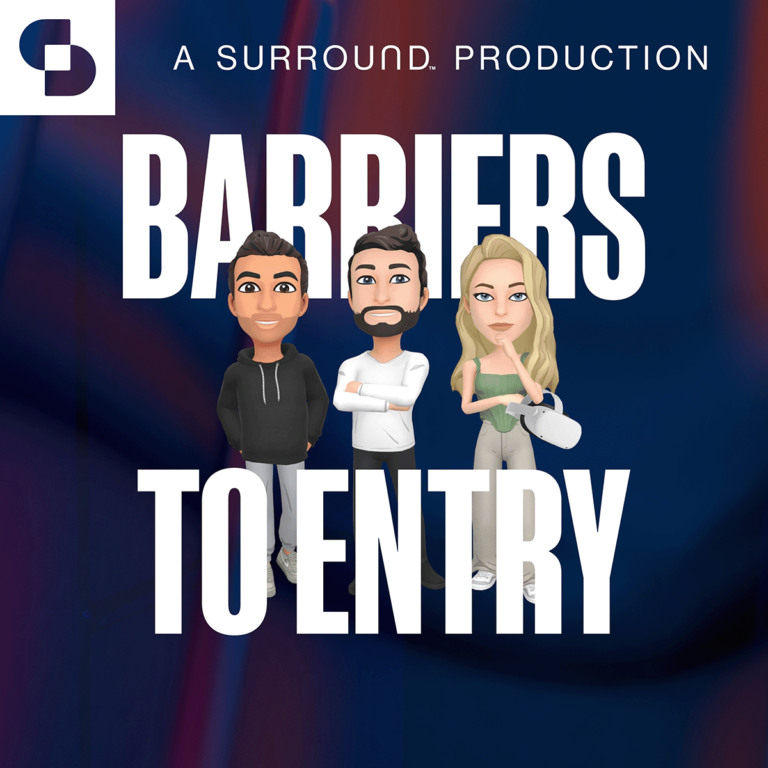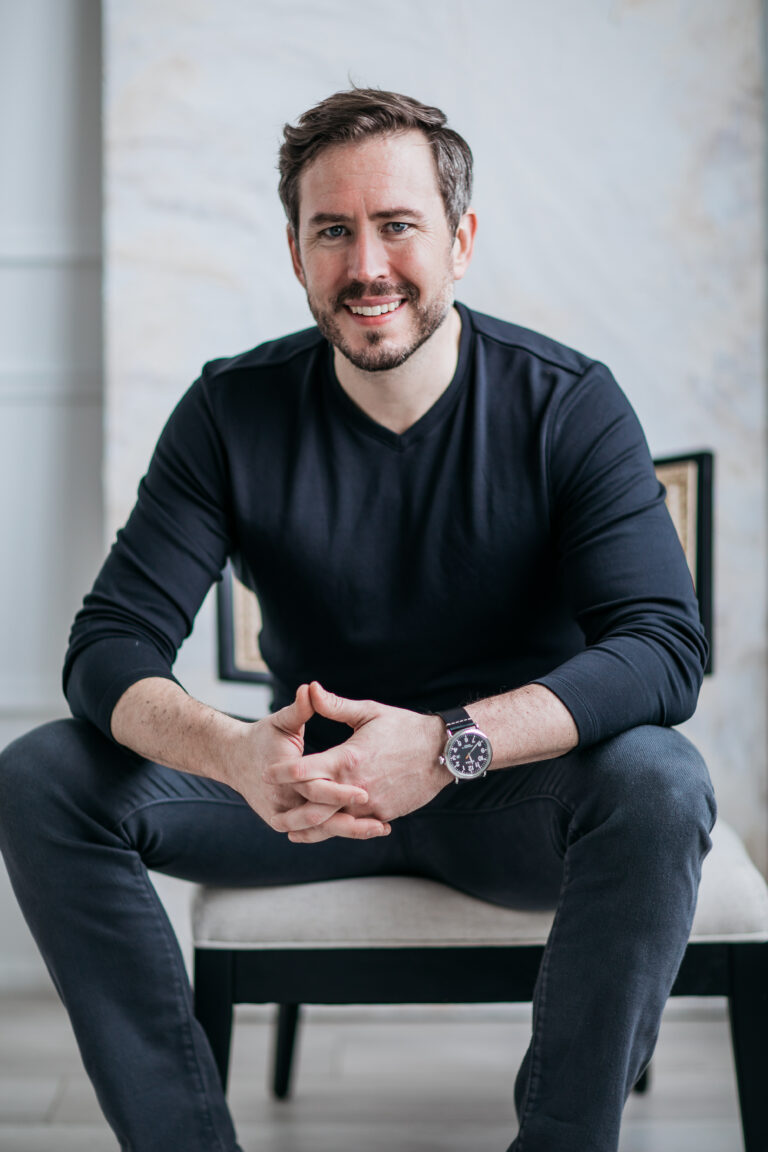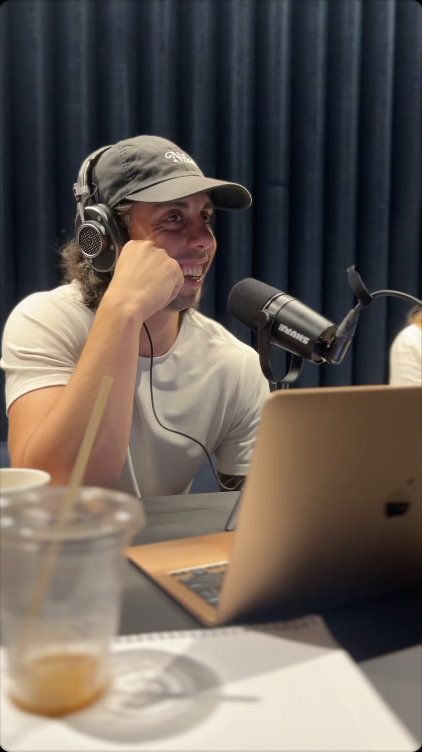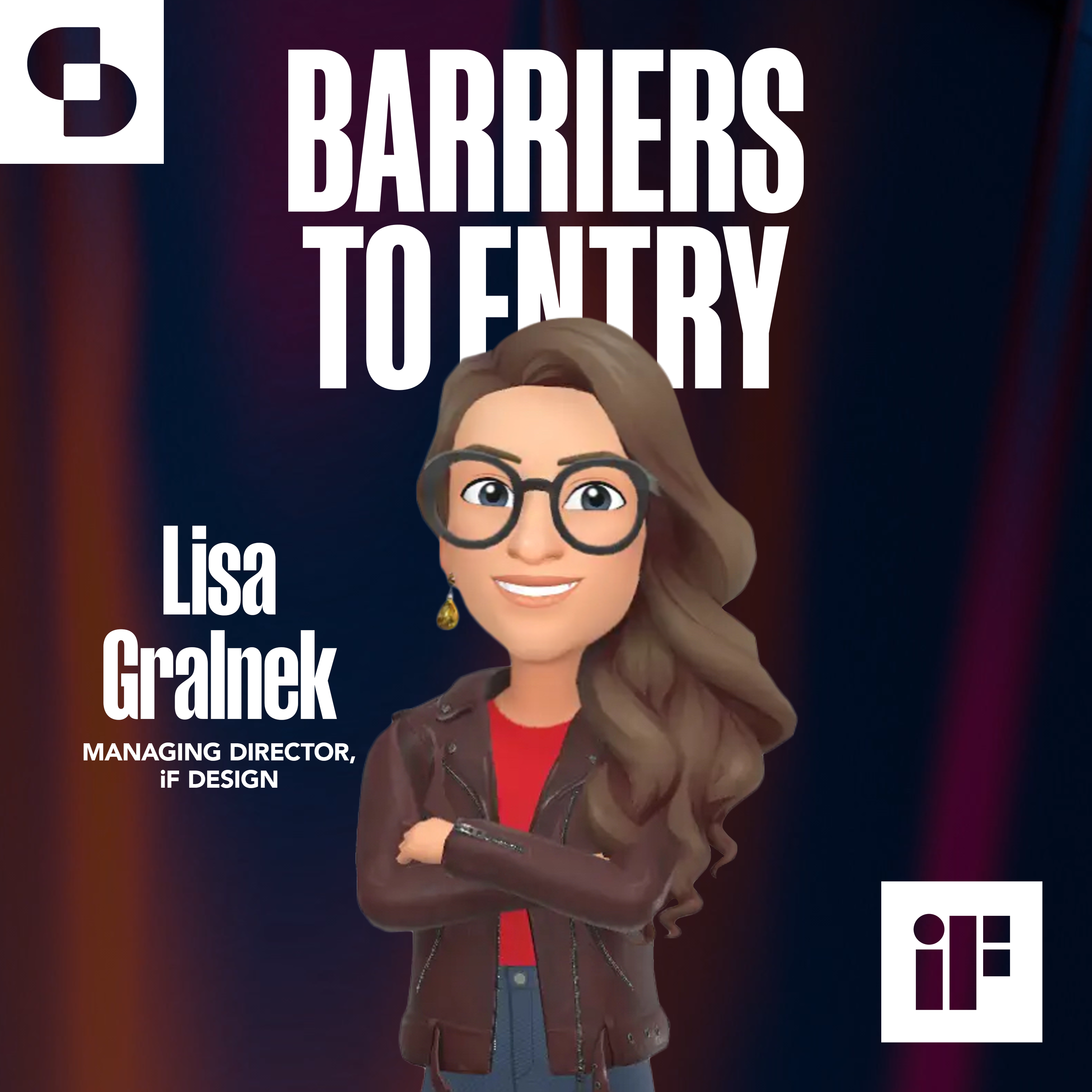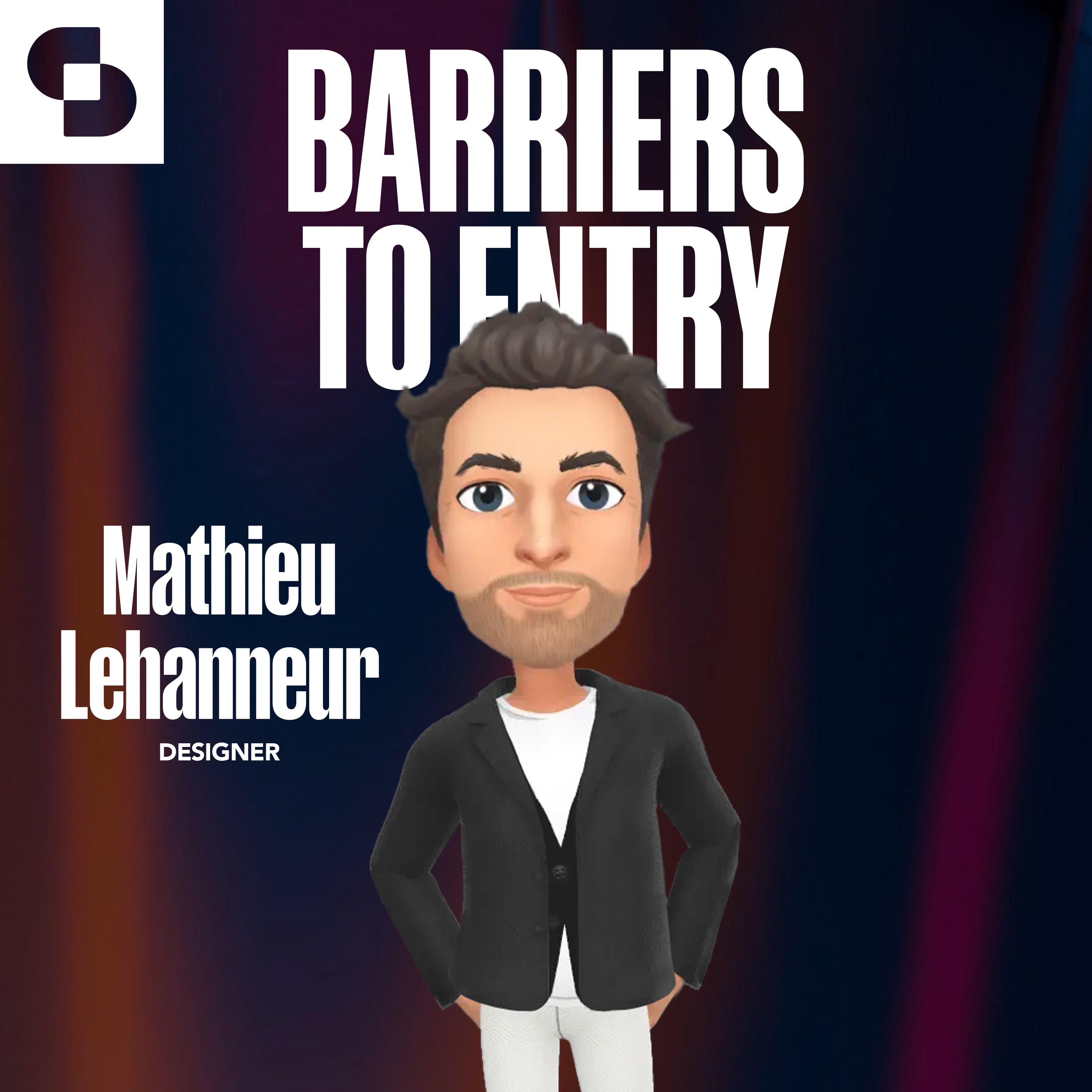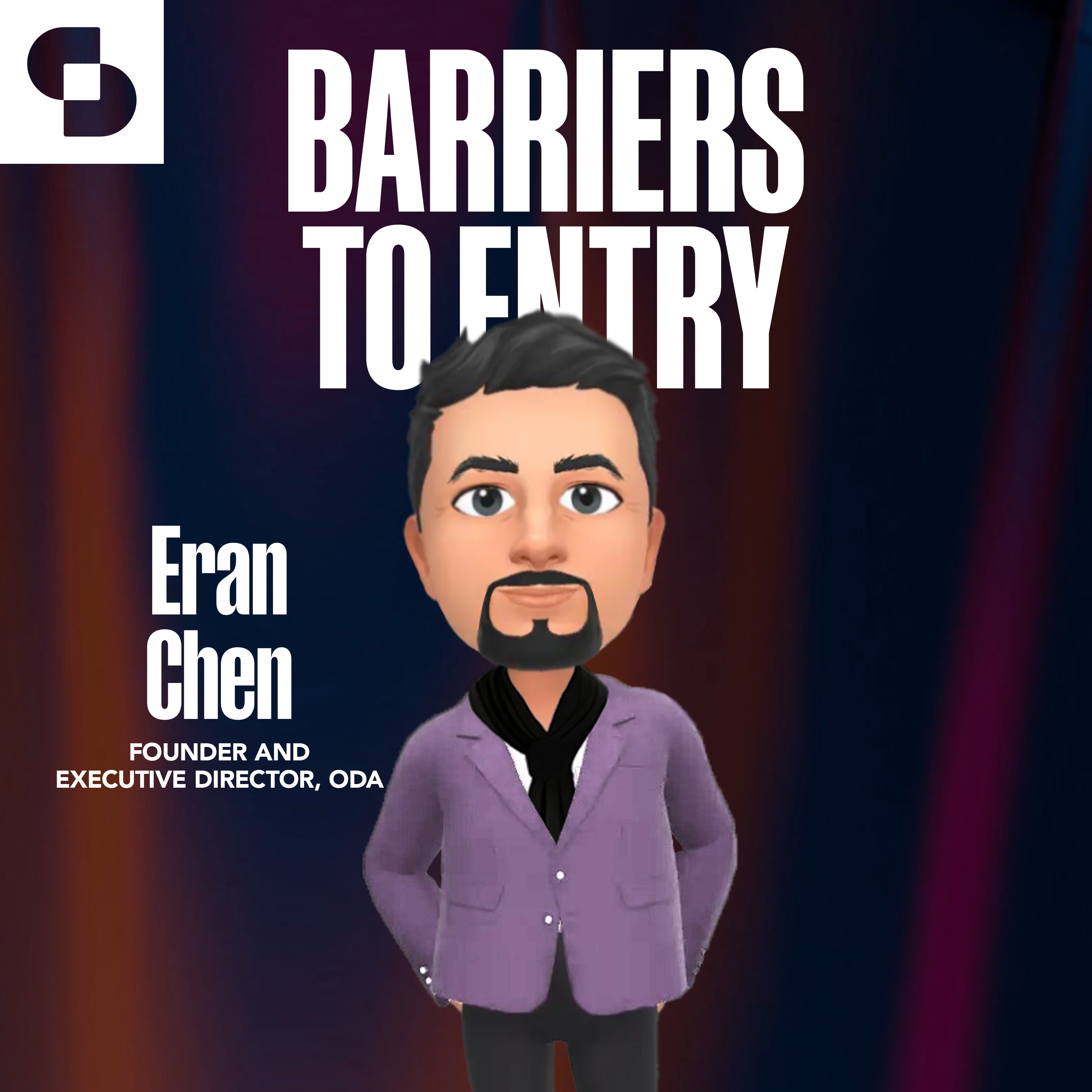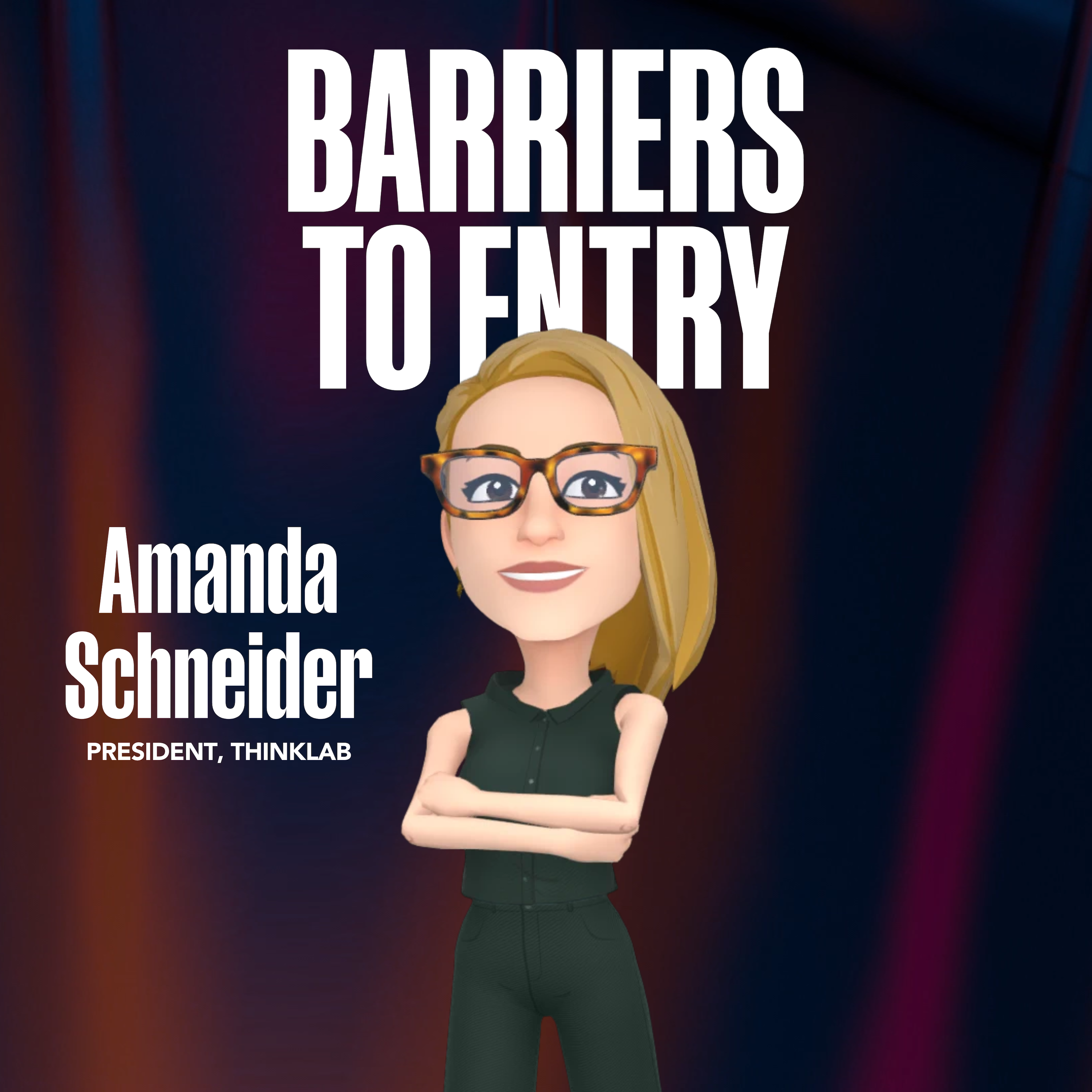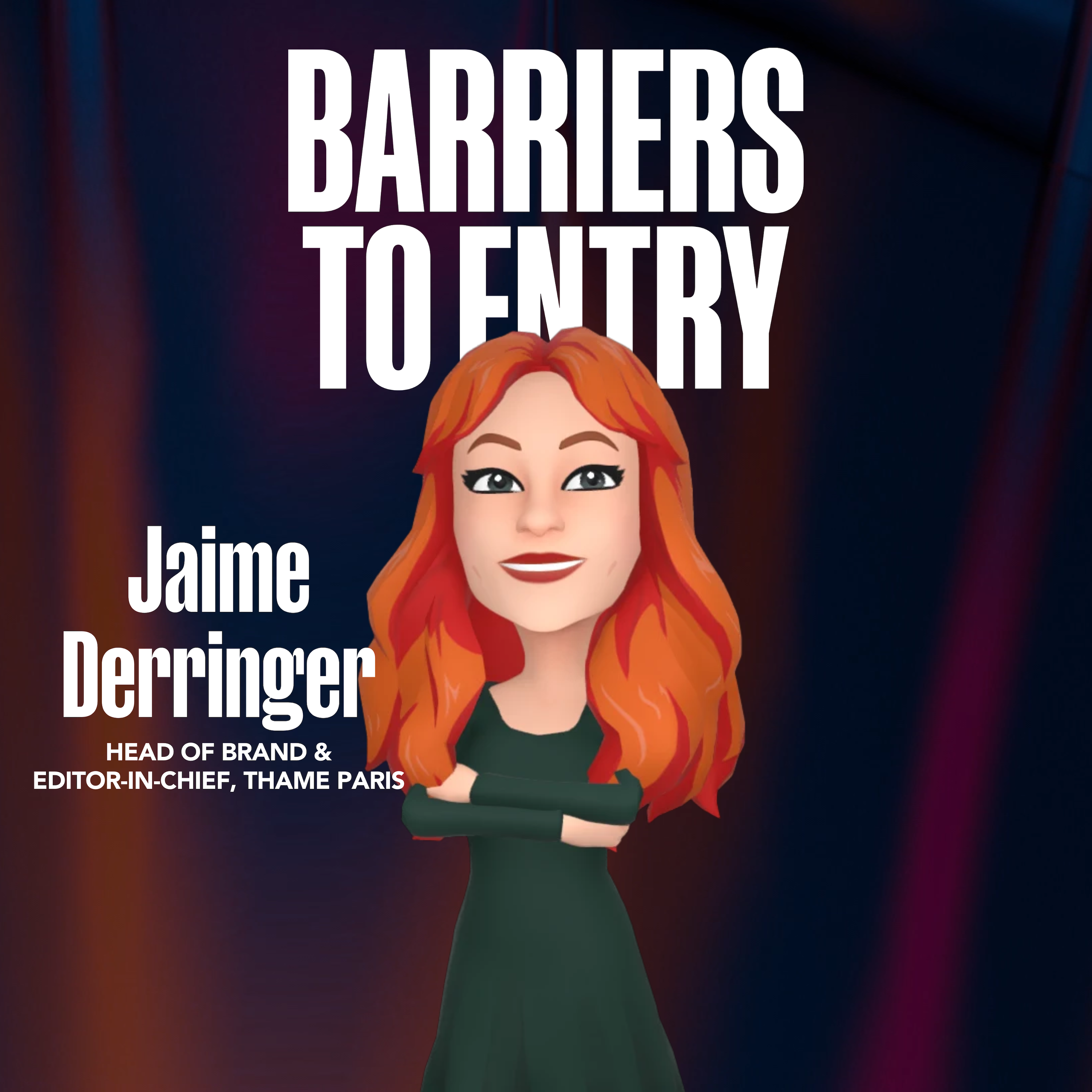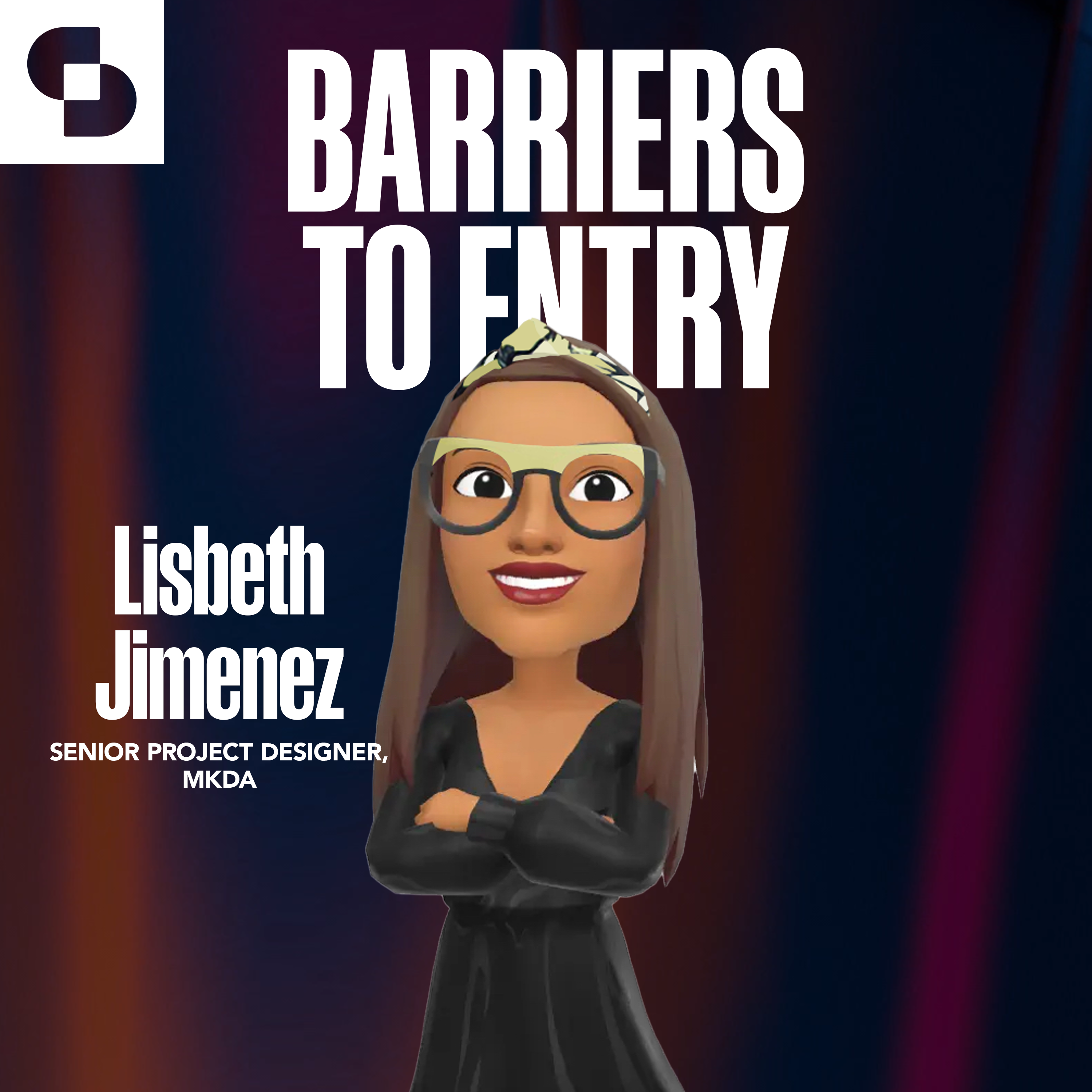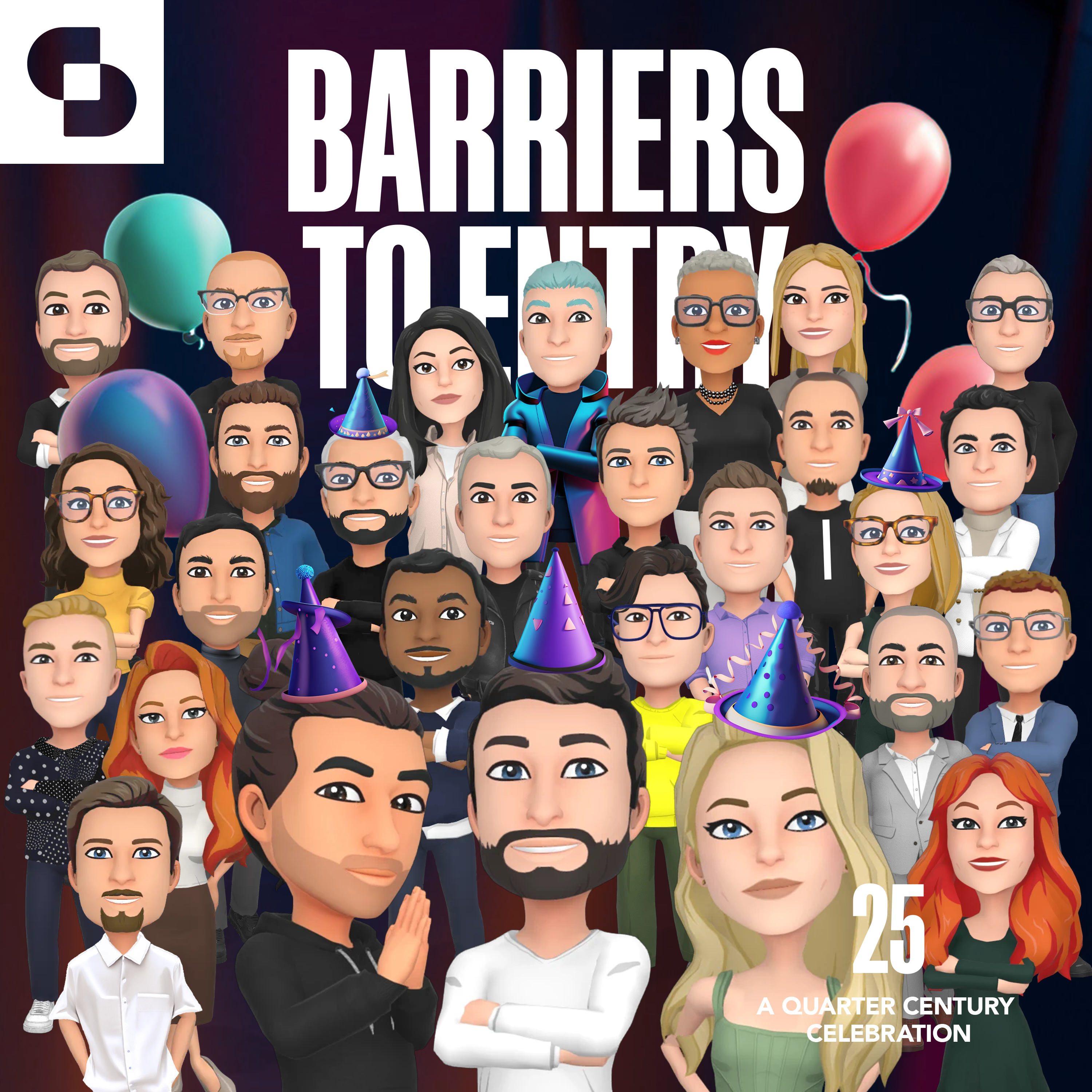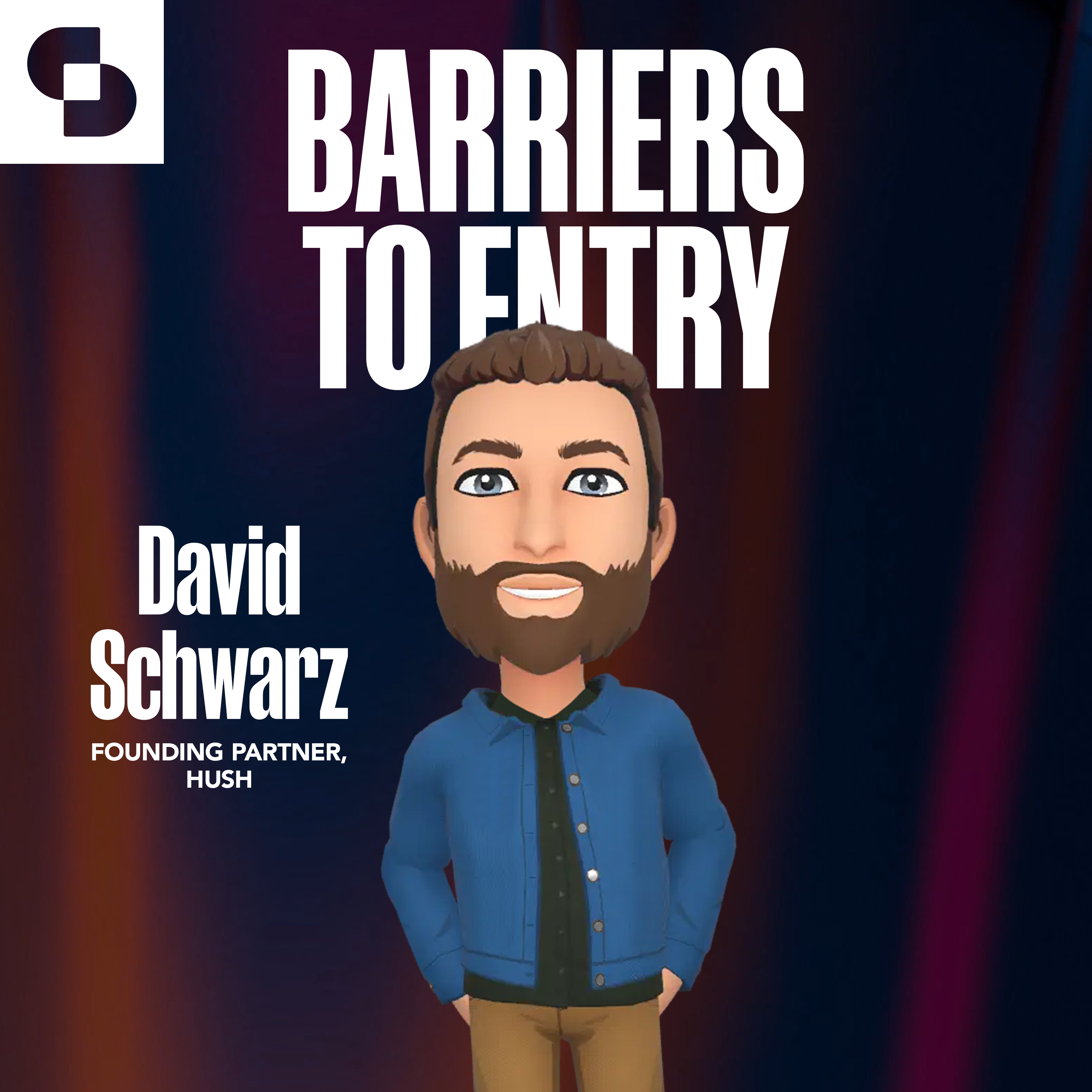This week on BTE – when emerging tech meets city planning…
This week we welcome a guest who’s credentials include being everything from an Urban Tech fellow at Cornell University to a multiple time startup founder and advisor to a repeat champion on Jeopardy. Greg Lindsay joins the gang to get into how cities (and by extension large groups of people) deal with technology being thrust upon them and along the way take a trip down memory lane to remember Foursquare, the introduction of Uber, and even Pokémon Go!
Connect with Greg Lindsay on LinkedIn!
Moments to check out:
- (starts at 8:42) Augmented Reality will be the killer app for Artificial Intelligence (and vice versa)
- (starts at 11:17) The challenges of regulating technology before it arrives
- (starts at 20:35) Burying ‘the metaverse’ and the role of VR in city planning
- (starts at 27:33) Improving collaboration between cities and technology companies
- (starts at 30:55) Opportunities for A&D in re-imagining the build environment
- (starts at 37:09) Considerations for building a responsible future
Connect with our hosts on LinkedIn;
References and resources:
- Greg Lindsay (.org)
- Cornell Tech, Jacobs Urban Tech Hub
- Death by Pokémon GO – Purdue University
- Hyper Reality (Short Film, Keiichi Matsuda, 2016)
- Agents (Short Film, Keiichi Matsuda / Niantic, 2023)
- Visual Positioning System (VPS) Definition
- Sidewalk Labs – Toronto
- Sideways: The City that Google Couldn’t Buy (Book)
- His Dark Materials, Phillip Pullman (Wikipedia)
- Numina (VR urban planning data)
- Dennis Crowley / Living Cities
- Lessons from the Catastrophic Failure of the Metaverse, Kate Wagner (article)
- Unfrozen (podcast) – Greg Lindsay and Daniel Safarik
- Rafi Segal
- Discord (Recommended follows: Living Cities, Liquid Cities, Niantic
Discover more shows from SURROUND at surroundpodcasts.com.
This episode of Barriers to Entry was produced and edited by Wize Grazette and Samantha Sager.
Learn more about your ad choices. Visit megaphone.fm/adchoices
Greg Lindsay: [00:00:00] It’s not like we’re blurring physical or digital. It’s like everything is a screen. So like, how do we think through that implication that we’re on the other side now that there is no, there’s no difference between real and virtual life. They are the same.
Tessa Bain: Welcome to barriers to entry the podcast where every episode we get into it with the leaders, the designers, the early adopters and the influencers who are driving innovation in the architecture and design industry.
It’s the metaverse, it’s AI, it’s blockchain, and it is all happening here. I’m Tessa Bain, and as always, I’m joined by my strikingly handsome co hosts, Andrew Lane and Bobby Bonett.
Bobby Bonett:
Oh, gosh.
Andrew Lane: No, I like that. I feel like the listeners who don’t get to see us every day need to be reminded sometimes, Bobby.
Bobby Bonett: Yeah, that was nice of you, Tessa.
I want to tee up today’s episode, um, because it’s not every day you get to talk with a two time Jeopardy champion, Andrew.
Andrew Lane: I once met Ken Jennings at some sort of a promo thing, but literally that’s the [00:01:00] only real comparison that I have.
Bobby Bonett: How long have you been holding that back?
Andrew Lane: It might be the first time I’ve ever mentioned it to be honest, but it did happen.
Bobby Bonett: I have a dear friend named James Holzhauer, but I’ve never met. A Jeopardy champion before, but yeah, today on the show, we have Greg Lindsey. And I know Andrew, you were just on a panel where Greg’s name came up several times.
Andrew Lane: Yeah, we were out at an industry meets technology event here in lovely downtown Toronto and the historic distillery district, shout out Toronto distillery district, and Greg’s name was fluttering about, he’s definitely someone who’s at the center of so much of this conversation that’s happening around how this technology.
is going to impact our built environments and really particularly focusing in on where that impacts cities. And so that’s obviously so complicit in what it is we do and what we talk about here on the pod every week. Greg brought up
Tessa Bain: a lot of really interesting points, specifically in the ways that cities need to prepare for technology, the liability behind that, but also how the community itself can sort of prepare for this oncoming technology and start to design in advance of [00:02:00] being ready for that.
So we’re going to talk about that a little bit more at the end of the episode.
Andrew Lane: All right, guys, what is time to start the podcast today on the pod? We are excited to welcome a man of many talents who’s bringing them together to help shape how cities are using technology to define their futures. He’s an urban tech fellow at Cornell tech, a senior fellow at the MIT school of architecture and planning future urban collectives lab founder at the AI driven real estate analytics platform, climate alpha, and to put a cherry on top.
The man is a two time Jeopardy! champion. I could not be more thrilled to welcome to the pod, Canadian resident, Greg Lindsey.
Greg Lindsay: Thanks for having me, Andrew. Aspiring Canadian, too. I’m aspiring. Aspiring.
Andrew Lane: We love that.
Tessa Bain: We learned about you and your work through the Metaverse Metropolis Symposium. Can you share with our audience a little bit more about that initiative and how it connects with some of your other areas of involvement?
Greg Lindsay: Absolutely. Well, as you can tell, I’m a man of many hobbies and many interests, and augmented reality in particular is one of them. So yeah, I’m an inaugural [00:03:00] fellow at Cornell Tech’s Urban Tech Hub. And the Metaverse Metropolis was really came out of a confluence of several things. One of course was my obsession with Pokemon Go back in 2016, which struck me like a bolt of lightning.
I think back to those first weekends in July 2016, just the pandemonium of crowds storming through parks. of intergenerational, multi ethnic groups of strangers sitting down to play the game together. Businesses that were either kicking out players or luring them in with Pokemon lures. So like using the digital layer to affect physical foot traffic.
As someone who was a student of Cities, it was, yeah, it was a real mind bender to suddenly see how in a single weekend. A new digital game could change the behavior of the city so much. And, you know, in that case it went away, the fad ended, much to Niantic’s chagrin. The legacy of that always stuck with me, that it could happen again.
And when it did, would cities be ready? And the second thread of that was I spent a lot of time at Commotion and New Cities thinking about the implications of Uber and Lyft and also Airbnb, in a sense, also these [00:04:00] disruptive companies that caused huge externalities to cities in, you know, in very negative ways that took years to figure how to regulate.
I mean, it’s been what, 15 years and New York City is finally cracking down on Airbnbs, for example, and LA had to write its own software to bring Uber to heel after federal lawsuits. So how can we tighten up that curve? How can we limit the damage that new technologies would do? Then the final piece of that for me was the Apple Vision probe, which has been in gestation for what years now.
And finally on June 5th, dropped. Still not, you know, the game changer. I think we all, I dunno, hoped or feared it would be in many ways, but, you know, with Apple coming into the game, like, is this gonna be the consumer breakthrough? Because, you know, just as the watch showed, for example, I mean, that was not considered a hit, but I believe it’s, you know, a hundred million units sold at this point.
It outsells the entire Swiss watchmaking industry. So when you tie that kind of device to Apple’s financial services ecosystem, is that how we get mainstream XR? So thinking all these through these implications of what it means for cities, and how do we not get fooled [00:05:00] again,
Andrew Lane: basically. It’s interesting the difference between the sort of slow burns and the quick emergences, like Pokemon Go went from 0 to 150 overnight, but you’re right about the watch.
The AirPod was similar. As well, everyone thinks that everything Apple puts out is an iPhone and it changes the game immediately, but they actually have a long history of products that take much longer to actually reach a market and become established. So it’s interesting to thinking about those two things and sort of the same conversation.
Tessa Bain: I mean, who of all of us played Pokemon Go?
Bobby Bonett: I did. Bobby? I did not.
Greg Lindsay: No. No. Greg? I did not. See, that’s why I have children. I have children who do this for me. Just, just like with
Andrew Lane: VR. I was one of those people who you honked your horn at who was like out in the middle of the street. Like, I wasn’t a particular Pokemon fan, but I was just like, I need to figure out what this is.
Like, I did it out of pure curiosity and then I was like, okay, I’ll figure out how to catch these things. So, oh wait, so you did play, Tess?
Tessa Bain: Oh, yeah. I know that’s kind of off character and off brand for me, but I absolutely played. I was all about it.
Andrew Lane: I love that.
Bobby Bonett: Greg, one of the reasons you [00:06:00] were fascinated by Pokemon Go and one of the reasons you have a negative outlook or attitude toward Uber is that it’s the danger resulting from the fad that was Pokemon Go and then inherent in the platform that is Uber.
So can you talk about that? That’s a little bit because that’s eye opening when you think about some of the statistics you’ve mentioned before related to those two platforms.
Greg Lindsay: No, absolutely. So there’s a famous paper, at least famous in these tiny circles, Death by Pokemon Go, written by a pair of Purdue University researchers, where they worked with the police in Tippecanoe County, Indiana, to look at changes in the games.
First six months or so. And so they found that basically that, uh, auto collisions around pokey stops with Pokemon spawned in the game went up 50%. Wow. So they calculated like the number of injuries and damage and, you know, use some mathematical calculations. And then they calculated that for like every county in the United States.
So back of the envelope. And in that back of the envelope, then that would have come out to about 30, 000 people who would have been injured by distracted drivers [00:07:00] playing the game. And so it’s fun for Andrew to get honked at for being in the street, but the real danger is the person driving the car, playing the game.
And at a time where, you know, pedestrian fatalities are all time highs from drivers in the United States, when you combine it with vehicles, it struck me there was a real and clear and present danger to cities in this, that this is a public safety hazard. And just like Uber was, there’s a paper, uh, also out there, I forget.
Uh, the name of it, but also shows that, you know, the ride hailing is introduced to new cities, that pedestrian fatalities went up three to five percent after the arrival of this one, as effectively driving norms became looser around that. So there are externalities that cities will have to deal with in this.
And, you know, and Pokemon Go is very instructive in that regard as well. Like, you know, I spoke to and had speak to my cohort, Boone Sheridan. He works for 18F, the government digital innovation agency in Washington. He lives in a deconsecrated church in Holyoke, Massachusetts. So this is important because.
Niantic, which was spun out of Google, used existing maps and chose houses of worship as places to put the gyms where you train your Pokemon to fight each other. [00:08:00] And so of course, Boon living in a deconsecrated church that wasn’t on the right map, people showed up the first weekend to basically sit outside his house and do that.
But Boone also found that the maps were incomplete, that there was a very opaque process to appeal to Niantic to remove from the maps, and, you know, there were a lot of ongoing external consequences that comes out of this, and that, and he also noted in our discussion, that Milwaukee County did pass an ordinance to prevent these kinds of games from being played there, and a judge struck it down, saying, this is…
Undue hindrance on the game company and that really you should do a better job of managing your park. How do you manage your park if you don’t know the game that’s dropped there? These kinds of paradoxes that come into play. So cities are going to be left to clean up the mess and they won’t even know what kind of messes they’re going to clean up.
So that was my initial concern on the subject.
Andrew Lane: Do you see any parallels in the quick rise and then slower fizzle of Pokemon Go? And I know there’s still people who are out there catching some Pokemon in the game, but the only other recent phenomenon I can think of that, that blew up like that really unexpectedly, and I mean, to your point about Niantic not really being [00:09:00] ready for it, it’s probably because it took off a lot faster than they expected.
The other example is ChatGPT. So do you see any parallels there? Have you thought about that at all?
Greg Lindsay: Yeah, I mean, the big parallels between the two is I think AI will be the killer app for AR and vice versa. And like the guru on this is Keiichi Matsuda, who’s the British filmmaker and AR artist who in 2016, Go, he released the short film Hyper Reality.
which is still referenced by professionals in the field of like what this all looks like at scale in kind of dystopian ways. But more recently, he just put out a new short film, which was partnered with Niantic, you know, maker of Pokemon Go, called Agents, which basically imagines that, yeah, that, you know, you’ll have your own AI agents that will be rendered through an augmented reality interface.
The film doesn’t show exactly how, but imagine that we live in this enchanted world. And this is Keiichi’s whole thesis that like spirits and ghosts and all these things will be the real interface. for both AR and AI. So I see those two together. But yeah, I mean, as a, as a fad, I mean, [00:10:00] you know, I mean, chat GPT is fasting its own way, but yeah, it’s going to be the confluence of those two.
And I think that underscores again, like, we’re not thinking weirdly enough. This is sort of a theme of my whole project for Cornell Tech is to really wrap your head around the second and third order consequences of this. Like the example I like to use is what happens if we live in a world where everyone has their own version of Taylor Swift as their best friend that you can talk to.
And some of us will have like the really high end Officially licensed by the estate version of T Swift and some of us will have like the knockoff Chinese version that kind of glitches in and out and like translations kind of off and you know, you’ll have T Swift and you’ll have like your dead grandmother who you talk to for advice, an LLM that’s based on her.
And, you know, you won’t want to do this through chatbots. You’ll want to see them. You’ll want to interact with them. And these technologies can feed into each other. So, you know, what happens when we’re all walking around and we have like a cabinet of our best friends and family members who we chat with?
And if that sounds crazy, I mean, this is what Evan Spiegel, the CEO of Snap, has been saying that, you know, in the future we’re going to spend time talking to people on our apps and time talking to [00:11:00] AI and it’s going to increasingly blur between the two. You’re not going to notice the difference. Yeah,
Bobby Bonett: as the parent of somebody who just came home from school the other day, And joined the Taylor Swift fan club and then asked Alexa to play every Taylor Swift song.
I can understand how she might want a Taylor Swift.
Greg Lindsay: When does that end? How many more days do you have to go?
Bobby Bonett: Alexa play all Taylor Swift. It was an interesting prompt. So actually now Alexa is playing Taylor Swift in the background. I’m going to have to ask her to stop in a second, but I want to go back then.
We talked about Pokemon Go. Andrew brought up chat GPT. How do you then, and I know this is something you’re passionate about, think about and approach regulating technology before they fully arrive? I know you need to be passionate about the fact, and I think it’s kind of a no no when you think about it, that we need to be proactive.
And considering the implications of technology as it relates to that. So how do you regulate something when you don’t know what it’s going to be yet? Yeah, I
Greg Lindsay: mean, that’s the meta question of the entire cohort. I mean, my final report, which is still in process, is to create the break glass in case of emergency instructions.
Like, here’s something to start with. [00:12:00] So, I mean, there’s several angles. I mean, there’s, of course, existing law. And when it comes to AR, you know, I’ve talked to folks like Jonathan Askin at Brooklyn Law, who’s done an analysis of how AR would be regulated in New York City, for example, and there it sort of falls into the tradition of outdoor advertising.
So, there are some regulations in the book. So, you can’t, like, blind or distract drivers with billboards. That does create public safety. So, maybe you can regulate that. I’ve talked to Kathy Hackle, who wrote Into the Metaverse. You know, her, one of her concerns is, like, air rights. How does it play out with, like, Intersection of property rights, like thinking about this.
So to me, it’s a question of talking to city agencies at the city level. And this is versus like federal regulation, but talking to the city agencies about where does that expertise live training staff to recognize this. And, you know, there’s, I mean, there’s a ton of work to be done in this. I just literally had a call earlier today.
About doing AR art in, in New York City parks. And it will not shock you to learn that like, there’s no guru of augmented reality for New York City parks. Like the city’s going to have to build out that kind of capacity. So it is interesting. Some of the companies are stepping forward with this. I’ve talked to snap, for example, their head of [00:13:00] education, a head of public policy.
They want to. Educate cities, they’re trying to get these tools into the hands of everyone and sort of play with the cities to help augment this. So what I’m hopeful is given that, you know, we’re going through another sort of XR winter right now, that maybe we can bring the big players to the table and work this out proactively versus trying to like fight over a pie that doesn’t exist.
But I think it’s interesting to sort of take existing regulations on the books and figure out how to apply those as, you know, implied sticks to, to work with the companies to say, Hey, like, let us, let us work together on regulating you. When this becomes an issue versus what happened with Uber, where like LA had to like write its own software and demand very granular data to understand what was going on with it, which triggered various privacy lawsuits made Uber and ACLU on the same side, but it happened kind of thing.
And that’s my fear too, is that like, we’re going to create multiple incompatible realities where there’s going to be the Google visual positioning system and Niantics and maybe snap and maybe others. And, you know, are cities going to have to, like, regulate what’s going on in all of them? Or will the companies have to?
Because there’s [00:14:00] also a big content moderation problem with this, too. Like, you know, like, you know, hate speech, racist speech. You know, is that going to be permanently emblazoned, you know, in AR at various layers? So, you know, from my perspective, it’s like education right now. I’m just trying to get these cities to pay attention to the issues.
And my report will have this sort of exercise where we did foresight. We basically wrote. Outlines of Black Mirror episodes and then sort of surface the concerns and try to impress upon cities like, you need to participate in this now. But, but you know, it’s tough convincing cities when there’s a fentanyl crisis, mental health crisis mm-hmm.
and fiscal crisis, that this should be something of top concern.
Bobby Bonett: They’re like, this is, do I need to worry about this right now? , I’m sure is what they’re
Greg Lindsay: saying to you. Mm-hmm. . And then the flip side is like, an ounce of prevention is worth a pound of cure. So that’s, that’s finding that thin line there about like, and this is my obsession is like having.
You know, again, instructions in case of emergency break glass, and I think AI is the next one for those and all sorts of other areas as
Tessa Bain: well. So how do our urban planners or architects or designers start to design for this and design for this influence in public spaces?
Andrew Lane: Or even [00:15:00] just to start thinking about it in the first place, yeah.
Greg Lindsay: Well, I mean, I don’t know. So from an urban planning standpoint, the question is, is, you know, I mean, my first question, I’m actually a city employer and planner is how can I work this? Like, how can I use this as a powerful tool in my favor? Because given like, for example, in New York, where you still have Midtown, I mean, obviously we have the sort of foot traffic problem without five day a week office stuff.
But you still have iconic locations like Times Square and Bryant Park and elsewhere. So my first thought is like, how can you use AR to deepen and extend the presence of those places and make them more iconic? And like Google recognized the same thing. Last December, they did a concert with gorillas and took over Times Square.
Like they didn’t do that in the middle of the field or Silicon Valley. They chose Times Square for a reason. So could you play with that? Part of it’s going to be understanding sort of how these visual positioning systems work. And I’ve, I’ve used that phrase. VPS is sort of the next generation of a GPS.
It’s where you Take that and then you build out maps down to the centimeter level, which is what Niantic wants to do to permanently locate objects or information. And so, for example, like I would say, you know, if I were an urban [00:16:00] planner thinking in like Tokyo, for example, where designers have taken chat GPT and Google maps and created walking tours of Tokyo as demos, it shows a strobing path on the ground.
Is that path safe? How does it cross intersections? Where does it go? And I’m curious about like, should we start thinking about like geo fencing certain areas, you know, where people should go or thinking about already, like what the way finding should be in these environments. I think urban planners need to think about like, how do we design visual language?
For digital layers, and I said, I just had a conversation with Jackie Lu, who worked for Sidewalk Labs in Toronto, where they designed some iconography for the sensing environments they plan to build. Like, so think about like how your remit now extends to those virtual levels. And then ultimately it’s going to be interesting to see what the real estate interests will do.
There are some players in this, like Jamestown, you know, which has Times Square Holdings. They’ve thought about how they can use this to enhance the value of their properties. I would start piloting with some very concerned players about thinking through like, how is this additive to their holdings? Or like, how do we create digital billboards [00:17:00] that go around it and other ways in which you can sort of use it to enhance the visual realm that will not have people walk into traffic.
Andrew Lane: You referenced Sidewalk Labs and that’s a good Google for anyone who’s listening to the pod Google Sidewalk Labs Toronto It’s a fun story that as we joked about in the prequel is now now a book and a play about it But do you and your colleagues seek out? experimental or forward looking opportunities like that to start to
I’m going to be the one who might be most eager to demonstrate some of these future looking planning ideas, but is that a path that you’re taking, or are you more focused on established cities, established areas, and what the impact is for more general populace in those
Greg Lindsay: places? The answer is both right now.
It’s very opportunistic and it’s all a case of talking to very smart people in positions that might do something about it. Two examples, either end of the spectrum snap, for example, has urban scale, AR lenses. So, you know, giving its developer tools to think about this at building scale. [00:18:00] The first three cities they chose were London, Los Angeles, and Santa Monica, where I believe their headquarters are adjacent there.
So you know, I think it’s interesting picking two very wealthy global cities to do this. At the opposite of the scale, I heard from a city councilor in Belmont, Massachusetts, which is a wealthy bedroom suburb just west of Cambridge. But he’s a volunteer and was thinking about the fact that they’re revising their zoning code.
And so he was interested. And How would we incorporate AR into this? How do we future proof our zoning? So you’re seeing some really smart around the corner people, but there’s no real systematic way of approaching this. You know, it’s just sort of like things pop up here and there. So I’m out there like searching for these right now, trying to find case studies of people who’ve done this successfully so we can try to move this argument forward about public servants who are There’s no reason they can’t.
You don’t have to wait for someone to drop Pokemon Go on you again.
Andrew Lane: So the other thing that you’ve said a few times on the pod is just alluding to the power of the AR and AI coming together. So you know, we’ve been talking about the starter examples, but [00:19:00] what’s the grand vision there? If those two powerful things do come together, like what are some of the opportunities that might exist that maybe our listeners aren’t immediately thinking of?
Greg Lindsay: For those of you who’ve read His Dark Materials by Philip Pullman, like that notion of the demon, your soul lives outside of your body as an animal. I mean, that’s where it’s going to go. You know, all these digital assistants and personas you have will live outside of you in the world, and you’ll be able to summon them.
But from a planning standpoint, this could get quite interesting as well. So again, Jackie Liu, who was involved with Sidewalk, I was just chatting with her. She just gave a talk on this in Calgary. There’s a vision of the web from almost 20 years ago, where instead of Big social media platforms vacuum up our data, you know, you controlled your data and you would have an interface to it That would go off instead of shopping on Amazon and all these various sites You would say I want a pair of shoes for 50 They should be this color and it would collect bids It would go out into the world and bring it back to you This could be AI again, and this could also be AI in the urban environment so therefore it imagines, you [00:20:00] know a world where basically you have AI agents that are negotiating with the world around you in terms of permissions where you’re going, what data you’re willing to give up to various sensors around you, whether those are cameras or 5G cell phone towers or the kinds of sensors they wanted to put in place in sidewalk Toronto, which was the whole focus of the battles there.
So it raises interesting questions about like, how will we provision. Our data and these permissions and these increasingly smart, which I’m using scare quotes if you can’t hear them, you know, environments like the kind that also, you know, the sidewalk introduced in New York with its kiosks and whatnot.
We
Bobby Bonett: always like to chat with our guests about the concept of the metaverse and the unbuilt environment and where we stand today versus where we stood. I guess Andrew and Tess a year ago, right? When we, when we started this pod and on the pre call, we chatted a little bit about Mark Zuckerberg’s meta and the effect Mark had on the phrase metaverse and virtual environments writ large.
I’m curious, you know, where you sit from your research perspective. [00:21:00] Just your take on unbuilt environments and where we’re headed as it relates to just the concept of the metaverse and maybe just a larger opinion on what’s hot right now in, you know, unbuilt
Greg Lindsay: spaces. First off, live by the Zuck, die by the Zuck.
I mean, RIP metaverse. New t shirt. Yeah, I think, I think we have to like dump that word in an unmarked grave. And I would feel worse for Neil Stevenson if he were not out there with his own blockchain based firm trying to build the underlying infrastructure for all these VR metaverses. So, you know, go with God, Neil.
But from example of sort of like built environment forms, I mean, there’s two directions. I’ve talked mostly about AR and I’ll plug one, but then there’s some interesting VR stuff I’ve seen as well in terms of like unbuilt environments. So in the AR side, I think another example of like a Of a startup that’s doing interesting work with cities and thinking through about unbuilt environments is in situ, which is in New York.
Dana Tremesch is a co founder and CEO of it. Originally I believe she worked with, I forget exactly how, but Alex Washburn, who was the chief design officer of the city of New York in the Bloomberg administration. So she and Alex started with it and she’s [00:22:00] definitely taken it and ran with it in great directions.
But it’s an AR tool using just smartphones to see unbuilt projects as a way to go to a site, pull up a QR code, or use their app and see what would be on this location. And given, you know, the incredible NIMBY interests that will fight any given project, here’s a way to go to the site and see what the massing would look like and have information shown.
Now, I love this project. She’s partnering with two cities formally. I won’t say who’s, I don’t think it’s official yet, but like working with the city governments to think about how they can apply this to inspections. Civic engagement and use this as a tool.
Bobby Bonett: You’ve said before, if you show people where development is coming, you think people are more likely to accept
Greg Lindsay: it then.
I hope so. That’s a very positivist outcome, right? Like, will that actually encourage them or will that trigger like more nimbyism? This is the question that remains to be seen. But I do like the notion of like showing them the future and seeing what comes of it. So that’s a great one and cities have really embraced that.
And then on the opposite side, on the VR side, you know, I think it’s interesting. There’s, there’s two companies that are working together that we hosted a symposium in March at Cornell Tech about this. Numina is a [00:23:00] German firm by Andrea Eon Kochikaru that is basically, yeah, providing the toolkit to build virtual environments, proving grounds.
for architects and planners to test out their theories. And her, one of her customers is Ryan Repecki, who was the co founder of Social Bicycles, which became Jump Bikes, which he sold to Uber. Everything connects. This is where I would have red string tying it all together. And then Ryan’s one of the people who wanted to build a city, like many other tech geniuses.
But working with Newman, he realized he could basically spawn the seeds of all these cities working there. And so they’ve partnered together to create and prove out what good urban districts could look like and create bits and pieces of blueprints. And Andrea is very smart about this in the sense of, you know, for her, it changes the entire contract between architects and their clients.
In the sense of being able to take the client into the environment and show them or have them move walls around themselves. Having them become active participants in the creation of a space. Both interior and exterior, you know, I just saw Andrea was on LinkedIn today. She was showing a video where like just changing street widths, you can just sort [00:24:00] of see how urban environments change around them.
You can change it almost as a slider. And so, you know, that’s an example of VR being an incredibly powerful tool in the same way that, you know, digital twins, physics based digital twins can be for planners to sort of see how this plays out. So I think there’s lots and lots of opportunities there in terms of, you know, having these virtual sandboxes where you can invite crowds in there.
And like, let’s talk about a bike lane, not on the street or in a community board meeting. It’s heated, but like, let’s just go to a place and we can do it on our computer screens, or I can show you on an iPad and look like, let’s play with it together. I don’t know. I’m a big believer in co creation. I hope that part plans out that if you can get people involved and they feel they have a stake in it.
I think that’s really powerful. And that’s where AI tools come back into play as well. Like, you know, generative AI to show remap streetscapes or, you know, put these in the hands of workshops of local residents and ask them what they want in these kinds of tools, like doesn’t have to be VR, but just ask them to render out bike lanes or render out a streetscape and then maybe sort of bring it back to these various tools.
So I don’t, I think there’s really untapped possibilities there [00:25:00] as well. So
Bobby Bonett: do you think, and I’ll borrow your words here, do you think at this point from a technology development standpoint, when we think about VR, we’re past this. Or we’re getting over our hangover from the pandemic era, and you’re encouraged by some of the tooling that’s being developed as we consider unbuilt spaces and how technologists are leveraging these unbuilt spaces and bringing them to their clients, for example.
Greg Lindsay: Yeah, absolutely. When you say pandemic hangover, that’s exactly right, because it is remarkable when I look at both the Quest and even the Apple Vision Pro. It’s like, Oh, you totally started development of this in like 2020, didn’t you? Or like, I mean, obviously Oculus goes back further, but it just reeks of this notion of like, well, we’re never going to leave our houses again.
So let’s build out the metaverse. Like, no, we’re social animals who want to be in social space. So yeah, I think it is interesting to see the tooling shift back towards like, how do we enhance the spaces that exist? Like, and that is, I guess that’s my own sort of like bent on this too. Like I want to, I want to pull people’s.
Heads outta their phones and least see into the world or see through the [00:26:00] world. So it’ll be interesting to see. I think, you know, the Apple Vision Pro is an interesting step in the right direction when it comes to the imp premature of Apple, even if it’s still obviously based on their own demos meant to be worn indoors or maybe on a plane.
I think it’s about as far outside as it got. But I’m interested in like, you know, other concepts I’ve seen like brilliant labs has a monocle, which you can insert over your eyeglasses and wear it around. It’s 300 bucks. It has an onboard high definition camera, but it has integration with chat GPT. So you can totally wear it and you can ask chat GPT questions.
Again, you have to pull out your phone, type into it. It has a hearing sensor. And so. You know, how will these tools be incorporated? It does raise something to see
Andrew Lane: that the monocle come back. I think also very
Greg Lindsay: distinguished aligned on that. Yeah. If you want, if you want geek, Andrew, I totally had my father, maybe when I was a kid, like actually tooled a plexiglass monocle.
So I was a kid walking around with a monocle in my eye there. I remember losing it and being heartbroken, but yeah, but it’ll be interesting to see like what that next generation will look like and whether, you know, whether we’ll see something disruptive in the sense of cheap and easy. [00:27:00] Sort of like spectacles or what, you know, Meta wanted to do with its wayfares.
I will just add that, you know, I am also deeply concerned about this, about maybe is this the final destruction of the norm against taping strangers in public space? I mean, when the Apple vision pro dropped and it had 12 cameras and sensors inside of it, and I realized I’m never putting this on my face because it does facial recognition and retina recognition and things that I.
I would not let other companies do even if you claim to be secure about it. So, you know, does this just take us deeper into the surveillance state? I guess, you know, we’re always surveilling each other.
Andrew Lane: I’ve haven’t been counting formally, but I think you’ve referenced, you know, an Apple or a, or a meta pretty much as, as often as you’ve referenced a firm that would probably be more under the radar for.
The vast majority of people who are out there. And I’m curious how you kind of feel that the developments and the progress that’s being made on both levels is going to play out because the general public and even, you know, the people who work at the cities that you’re trying to influence are going to be [00:28:00] far more familiar with, you know, Mark Zuckerberg’s investments in meta and the vision pro than they will be with the myriad of other firms who are doing, you know.
equally, if not more important work. So, you know, how do you see that balance playing out? And just would love your take on those two forces pushing against each
Greg Lindsay: other. Yeah, I mean, the best person that I’ve spoken to about this is Dennis Crowley, who was the co founder and still chairman of Foursquare.
Dennis is co founder and head of product for a startup called Living Cities, based in New York, you know, that is very XR focused. And so it’s interesting. So obviously, yeah, Dennis goes way back in 20 years of. Urban informatics and particularly with game mechanics and like, you know, gamifying four squares.
So everyone will check in and offer the location data. So you could be mayor of a place. I remember the day I finally woke up and during the pandemic, I’d be like, why am, why am I checking into places when I’m not going anywhere? So that’s how the kind of grip he had in our mind. But yeah, Dennis, you know, his new startup, you know, they were basically building out a digital twin of Washington Square Park as an early experiment about like, how could you build [00:29:00] a mirror world of Washington Square Park?
And then what would be the game mechanics between the two? And Dennis being conscious about this was going to ask the Washington Square Park Conservancy about like, how would they play in this space? Or how would they do that? Which I think is Number one, very interesting. He was going to try to partner with the city and think about this.
But number two, you know, Dennis made the point when we were having these discussions is that, you know, in the Bloomberg administration, at least, there was a point person for startups and these kinds of things. And cities do need to think about, like, how do you have an open door to these startups or other would be disruptive players?
So that they can work with you and ask for permission very easily versus asking for forgiveness later. And I did have Dennis address my cohort of public officials, and it was really fascinating because they were asking very determined questions about, Well, why are you doing this thing? Or what is the reason for the kind of game you are making?
To which Dennis replies, Sometimes there is no why. Sometimes you just experiment. You just sort of see what sticks. And Neither Dennis nor anyone else know what that winning mechanic will be for AR in the real world. Pokemon Go bottled it because of nostalgia and the [00:30:00] IP and the then novel interface. But like, other than that, like, no one managed to capture that lightning again.
They’re all trying to figure it out. And Dennis was the one who wanted to basically have cities help him see if he could figure out what that game mechanic would be. You’ve also just
Andrew Lane: interested me in the Dennis Crowley vs. Simon Sinek grudge match around the
Greg Lindsay: Y. Well, there you go. Yeah, I mean, I just thought it was interesting in the sense of watching this attitude.
To me, it was very telling. I understood, finally, that sort of Bradley Tusk, Urban Disruptor thing of like, If you try to ask permission from the outset from city officials, you’ll just be stuck forever, right? You know, you’ll be caught in their decision making loops. Because there they were completely flummoxed that Dennis was just simply casting about, trying to find a mechanic that would unlock it.
We still don’t know what’s going to be the big breakthrough. And, you know, it’ll be interesting to see, you know, that could be tomorrow. It could be seven years ago, like Pokémon GO was. It could be never. I’m open to the possibility that it’s certainly going to be never. That would not necessarily be a bad thing to, you know, have another 30, 000 people get hit by drivers.
Tessa Bain: So, previously when we chatted, you said the built environment is perhaps one of the [00:31:00] greatest environments for wealth invention. And so, you spoke about it a little bit earlier, but as we begin to see the opportunity of designing the unbuilt environment as well, what does this mean specifically for architecture and the general practice of creating spaces?
So even interior design and architecture,
Greg Lindsay: all of it. Yeah, I mean, there’s so many implications of it, right? I mean, interior design, too. Just as this is a side there, I used to joke that, like, if VR took off, would we see, for example, as a second order effect, like, uh, a huge new interest in McMansions, where the most important room in your house would be the VR room, just a giant empty space, you know, that you would fill in?
What would be the consequences of enclosed VR world versus an external AR world? Because it struck me, again, another legacy of the pandemic. Like, just as we’ve seen people leave dense urban areas for larger homes in the Sun Belt, You know, will VR be part of that? And also, this is, this was mooted, you know, this past summer and fall during the wildfire smoke.
Just like we pivoted from, you know, like, Oh, we’ll need VR because we’re never going to leave our house from the pandemic again. It’s like, Oh, now we’ll need VR because it’s unsafe to go outside for weeks at a [00:32:00] time. Like this idea of an urban fallback technology, I thought was really interesting and dystopian to say the least.
But when it comes to like, you know, again, being really the built environment, I mean, it was interesting in our, in our threat casting exercise, it was a great thought that somebody had that, you know, when the tech companies woke up and realized the kind of value they were going to create a dense urban space, perhaps we’d see them invest even further into real estate, you know, it is interesting that Google and Amazon and others are still investing in urban campuses because of their workers there, where they use this as an opportunity to, you know, buy, you know, land in Midtown or in other undervalued areas, understanding the value that AR would add to that.
How would it change real estate investing portfolios? I thought was very interesting. And again, it’s a, it’s a question of like, you know, yeah, what would be additive to it? I don’t know. It’ll be interesting to see how it plays out with AR in space. Perhaps when it comes to apartments, AR will actually, you know, make smaller spaces more valuable, make it more livable in a way, because you’ll deepen the intensity of it.
So I mentioned Dennis, by the way. Dennis started with making a digital twin of Washington Square Park. [00:33:00] Where the company has ended up their minimum viable product right now is to basically turn your living room or your tabletop Into like a game board where you have miniature figures of friends and you can play various games there So this idea of like really intensifying the smallest possible space, you know Maybe that makes life in Hong Kong that much more interesting or in Tokyo or in these kinds of smaller environments So it’s it’s way too out there but but again I think the really interesting thing when it comes to those is like So beyond obviously the obvious remit of spatial designers, like, how should we think about those implications?
Or like, do you, you know, yeah, do you partner with them? Do you experiment with it? I’m not sure. The one thing I will say though, is like, you know, it is interesting that architects and designers have to be very careful to like not get burned, like watching them rush blindly into the metaverse. We’ll create metaverse spaces and profit off NFTs like, you know, Kate Wagner wrote a really scathing essay about that in the nation, which I agree with, but like, it just makes architects look like fools and had made to this.
I think it will behoove them to, you know, to, again, think very critically about how these technologies [00:34:00] change behaviors and to, you know, make sure that it does so safely for us, if that makes sense.
Tessa Bain: Or even just the influence of the digital and physical spaces, a term that we have brought up many times before on the pod, and we’d love to get your feedback.
It’s a bit of an informal poll for us, but what do you think about the word fidgetal?
Greg Lindsay: A very unfortunate portmanteau. Let’s see if we can do better. The writer in me demands that we do better. Consistent.
Andrew Lane: Do you have any suggestions, I guess? Because maybe we can start turning the poll into a little bit more of a full survey.
If
Greg Lindsay: I did, I would put it there. I mean, I’ve pivoted away from saying the metaverse metropolis, because, again, put that word in an unmarked grave, and shifted to the augmented city. And I like the idea of augmentation, because it also goes back to, like, you know, that Marshall McLuhan phrase, you know, that every new medium is both an extension and an amputation.
So, you know, how do we, how do we try to capture as much of the augmenting as possible without losing as much? but yeah, that’s sort of blurring of the two. I mean, it reminds me of like bricks and clicks and things like that back in the day, there’s no real easy way to capture it again, I thought of another awkward phrasing that just quickly is, you know, you know, my [00:35:00] final report, which I’m still writing has sort of two epigraphs on it.
One is of course, from first letter of the Corinthians, a glass darkly for now we see, but through a glass darkly. Which is this idea that, you know, that we don’t see clearly the face of God in the Bible, but we don’t see clearly the future we’re making. And then the other one is from William Gibson from Spook Country.
The internet is everting, which is a really awkward phrase. The idea that like the screen is turning inside out. We’re now pushing the screen out into the world. I think that’s more what it is. It’s not like we’re blurring physical or digital. It’s like… Everything is a screen. So like, how do we think through that implication that we’re on the other side now, that there is no, there’s no difference between real and virtual life.
They are the same. It’s just in various. Vectors or various gradients, if we
Bobby Bonett: were to read that paper, once you’re wrapped up with it, would we view your take on where we’re headed as it relates to the future of cities as you being an optimist or a
Greg Lindsay: pessimist? I think you would see it as both because, and I think, I guess you’d have to pick me ultimately as a pessimist for now, because [00:36:00] I, I firmly believe that the optimal outcomes will require more agency, more active involvement from both.
Communities and citizens at one level, and then also particularly public officials in this, the public, the same public officials who don’t have the resources or the time or the tools to deal with the challenges they have now. But I think it’s incumbent upon that. I mean, we have the phrase that we’re working with, uh, unchecked tech, uh, in that case ar along with AI to which of other technologies is just part of this ongoing vector of technology running rough shot over cities.
Partly due to arrogance and hubris of their makers, and partly due to that spirit I mentioned in Dennis, which is like, we’re just trying to make things work and get it adopted, and you worry about the rest later. And it leads to these outcomes. And so, you know, a positive outcome would be one where like, the negative externalities and positive benefits are in balance and in check.
And that might be like a knife edge, right? A really unstable equilibrium. And I’m hoping that we can help nudge in that direction with my work and the cohort we had assembled on this one. But, you know, it’s obviously extremely hard to do, so. I don’t know. If you [00:37:00] extend from the present, you got to be pessimistic.
But you know, what is the phrase by, um, Ramsey? You know, pessimism of the intellect, optimism of the will. I guess that’s, that’s where I guess I’m coming from.
Andrew Lane: Yeah. I think what you’re saying is really interesting. And like, we had a few months back, a bit of a round of sort of the founders of artificial intelligence and some of the early stakeholders coming out in the media with these like doomsday, like we need to stop AI now or something horrible is going to happen.
And then people would say, well, what? And they were gone before they had the chance to kind of answer. Um, but you’re still here. So I wanted to ask you, while you are, you know, do, do you and your colleagues have any thoughts around some of the guardrails or some of some of the things that people should be thinking about to ensure that they’re being responsible?
I think that the, the, the, the spirit that Dennis and others are bringing to this idea of maybe not needing a why is wonderful, but at the same time, you can do that without being reckless.
Greg Lindsay: I would put it in in two ways. So the, at the end of the workshop and the end of our analysis of it, that’s generating the report, my friend [00:38:00] Brian David Johnson.
Who’s a real futurist. He was at Intel in his Arizona state now, as he put it, it’s about power. In the end, it’s all about power. These technologies simply exist to reify power and they on their own, of course, will not break existing patterns of power. The only thing that can do that is to change the institutions and norms around them.
And you know, yeah, the government could do that and hopefully citizen pressure can do that. It’s the technology itself will do that. So that’s the first thing that stood out for me there. And then the second speaker is, was Chris Gilliard, who’s at Macomb Community College, better known as Hypervisible, when he was on Twitter, has been a frequent, powerful critic of surveillance technologies and how it affects marginalized, racialized populations.
And, you know, he, he sees a straight line between these two in the sense of, you know, again, like, he had a great example during our cohort of, you know, when Google opened reviews on Google Maps, you can imagine what the reviews of Auschwitz were like. You know, a torrent of anti Semitic commentary. And it raises questions like, you know, will companies regulate that?
Will they [00:39:00] moderate free speech? You know, how do we enforce the kinds of norms in these places? And it’s exactly the issues that just come up over and over and over again. And I guess my final takeaway in this is like, yeah, metaverse, the augmented city. It will simply be the new battleground for these issues, the new frontier, which is a loaded word too.
And it’ll never be resolved until we see institutions step up to curb that. And I guess that’s what makes me hopeful about AI, just to pit it there quickly. It’s really interesting to see that. So, you know, I’m not worried about it ending the world. I’m worried about AI. In the form, for example, of facial recognition with its obvious biases towards, you know, people with darker skin tones, that being used by police forces to surveil and apprehend often the wrong people, or even what’s used to apprehend the right people, it’s problematic.
But there we’ve seen the EU and other regulators immediately step up on this. Like the fact that the EU AI Act would effectively ban facial recognition, or at least strongly curtail it. And we’ve seen cities around the United States, like I believe it’s Somerville, Massachusetts that banned its public agencies from using it.
So I’m hopeful that, you know, [00:40:00] maybe we’ll start to see this, the, the, you know, uh, a bend in the curve that like, finally, we’re starting to realize that we have to rein in these technologies and do so faster and with more alacrity than we have in the past. And we’ve certainly seen that with AI and hopefully that means that when AR has its second coming, we’ll be ready.
Andrew Lane: Yeah. I liked your concept about the AR guru for major cities and things. I think it’s about time that we start to see some of those roles.
Bobby Bonett: We love to start to wrap each episode by. Giving our guests the mic and if there’s anything you’d like to promote or plug, I know Greg, you have a podcast, so we’d love to hear about that.
And any other initiatives you’re up to that you’d like to share with our listeners?
Greg Lindsay: Sure. Thank you. Well, all right. The podcast I like to plug is on frozen. We’re all finer podcasts are sold. It’s the podcast I have with my friend, Daniel Sepharic. Who is the head of research at the council on tall buildings and urban habitat.
So that’s where Dan and I like to go riff with guests on, yeah, cities and projects and the metaverse occasionally and all these fun, fun things. So please go listen to that if you want to hear more of my dulcet tones. Also would like to plug, [00:41:00] obviously my colleagues at the Cornell tech Jacobs urban tech hub.
We can drop a link there in the show notes as well. That’s where my final report will be published and get that out there. And then I guess, you know, among other projects, we’d love to plug my friend Rafi Siegel at the MIT Future Urban Collectives Lab, where we have a whole separate discussion there about looking at how that blurring of the fidgetal is happening when it comes to, yeah, but then we’re looking at physical and virtual communities and how they can be used to enhance each other.
So another of my interests, but I could, I could go on for all of my projects, but you know, also drop by Greg Lindsey. org to. See what I’ve been up to.
Andrew Lane: Love it. Yeah. We’re going to be busy time with this show notes this week.
Tessa Bain: That kind of dovetails into our final question to wrap today out. What advice would you give or resources that you might share with our listeners out there that are just looking to learn a bit more or even get started?
You know,
Greg Lindsay: I guess my real answer to that is at discord. You got to go hang out on the discords. You know, I know that makes me sound like a crypto kitty, but like actually where I keep. The closest tags and everything that’s happening is on various discord channels. I would [00:42:00] recommend liquid city, which is Keiichi Matsuda’s.
I would recommend living cities, which is Dennis Crowley’s. You notice it knows theme here. This is why I follow this. I would recommend Niantic. So they have one for the light ship and I could go on and on here, but that’s where a lot of the discussion, the user groups is happening where you see.
So I’m going to the state of the possible right now. So that’s, that’s where I try to stay as close to the metal, so to speak, as I possibly can in about how this is actually developing.
Andrew Lane: Thanks so much for joining us today, Greg. This was a great conversation. We are going to be very busy putting together the show notes for our audience on this one, but we can’t thank you enough for stopping by sharing the insights, having a couple laughs, and we can’t wait to see where your work goes and all the impact that we know it’s going to have out there on both the digital and digital and
Greg Lindsay: real worlds.
Well, thank you all so much for having me. I look forward to seeing you in the not Metaverse very soon. Thanks, Greg.
Bobby Bonett: Well, if you’re walking away from that conversation and your mind is blown, you’re just like me. Because that was a lot of information to process, but unsurprising considering [00:43:00] Greg’s credentials and I would say positions that Greg holds and a lot of provoking thought that Greg shared.
For us to walk away with some of which just applies to our day to day life test But some of which really is a fastball as we consider how to apply this to the architecture and design industry I
Tessa Bain: kind of love when I feel like the least intelligent person in a room It’s like a really good moment to just check with yourself and I am okay since then but fascinating conversation so much to think about I think the biggest takeaway for me when we think about as architects and designers, like, what does this mean for the community moving forward?
What does this mean for city planning, urban development? How can architects and designers start to look into this technology, explore it a little bit to see how they can design and design responsibly with this new wave of. AR coming forward.
Andrew Lane: I think the biggest takeaway for me from the interview was that Tess played Pokemon go.
That was something that I, I didn’t know that at all. I didn’t see that coming, but I really appreciated how much she leaned into [00:44:00] the specific stories around tech. You know, the statistics of what Uber coming to cities, like it really is something that we often don’t think about. And when you think about where cities are at in terms of scraping and clawing to try and, you know, balance their budgets.
This kind of stuff is just really difficult to get on their radars and to convince them. Yeah, you really should have an AI czar Chicago or whatever, but it’s such an interesting move forward opportunity. When you start thinking about the amount of companies or cities, I should say that are trying to brand themselves as places for tech companies to come in and to invest, it’s, it’s an opportunity there as well to start to really think about.
So how does your city consider technology at a broad level? And that was something that Greg is really bringing to life in an exciting way.
Bobby Bonett: And I’m just going to kind of build on what both of you said. I like to ask you using the word responsibility. We had a number of folks at the Sandot Design Group organization who attended the HubSpot inbound conference.
A lot of discussion in that conference about being early and finding ways to embrace AI in your organization. [00:45:00] And then Greg, in his discussion, Andrew, you mentioned the need for cities to think about onboarding an AI czar. And Greg, Pounding on doors and saying, we need to think about the implications for what technology is going to mean for cities.
We can’t wait until we’re too late and AI or, or emerging technologies have taken over and we’ve allowed, you know, ourselves to fall behind. And I would just take that and extrapolate that as a challenge for, you know, as we talk about all the time on this podcast, getting ahead and thinking about how you embed in your organization, it’s never too late.
Until it’s too late. So listening to a guy like if you could see Tess, I mean, she just nodded. She loved that. It’s not too late. I think that’s a new T shirt. I loved
Tessa Bain: it. I was going to say it’s a new T shirt. Thank you, Tess. I wasn’t sure if we had one, but it’s a
Bobby Bonett: beautiful T shirt. I think challenging your organization, identifying that individual in your organization to go ahead and say, let’s start to experiment here and think about what the implications for these new technologies might be for the way in which we do business is an important challenge and something that Greg is certainly hyper focused on as we heard today.
Well,
Andrew Lane: I think that was just another fantastic conversation for all [00:46:00] of us. And I appreciate your sentiment there, Tess. It was a good moment to sit and check yourself when you listen to all the. Connections that Greg made and, you know, I’m still getting nervous about how intense our show notes are going to be for that episode because of the amount of references that he brought forward.
But I think maybe it’s time to, uh, send it to Final Jeopardy here, guys. All right. Well, I want to send a big thank you out to our entire various entry production team, Wize Grazette and Sam Sager, but also our guest producer, the podcast award nominated. Rob Schulte, as well as everyone back at the studio by Sandow back in the pod cave.
Barriers to Entry is a part of the Surround Podcast Network, and make sure that all of you go to surroundpodcasts. com, smash that follow button and follow along, join us next time as we continue to break down the barriers to entry. I’ll take outro jokes for 200, please, Alex.[00:47:00]

